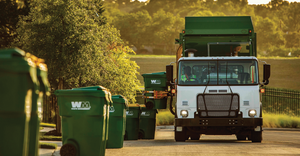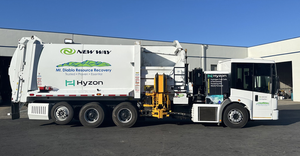A New Era
ON THE LAST DAY OF APRIL, Oneida and Herkimer counties in New York finally saw the long and winding defense of their flow control laws come to a national headline-making end when the U.S. Supreme Court, in a 6-3 decision, upheld the ordinances. But, the conclusion of Oneida and Herkimer's saga marks the beginning of a new era in flow control.
By upholding the counties' regulations, which mandate that all trash generated within the counties must be brought to publicly owned sites, the high court told local governments that they can, without discriminating against interstate commerce, pass laws directing waste to their facilities. The ruling invites similar ordinances by cities and counties across the country.
Predictably, the public and private waste sectors and their representatives had very different reactions to the decision. “The majority made the right call,” says Barry Shanoff, general counsel for the Solid Waste Association of North America (SWANA), Silver Spring, Md. “What we have here is a decision that reaffirms and endorses the role of local government in solid waste management in a way that I've never seen.”
Meanwhile, “we were clearly disappointed by the court's ruling,” says David Biderman, general counsel for the National Solid Wastes Management Association (NSWMA), Washington. “It reflects a different judicial philosophy from previous courts. What the court has done is create a distinction between flow control that benefits privately owned facilities and flow control that benefits government-owned facilities.”
Despite their differing assessments of the Supreme Court's decision, advocates for both government and industry agree that the impact of the ruling won't become apparent for a while, perhaps several years. Members of the public and private waste sectors alike will be watching the next few years with much anticipation.
The Road to the Supreme Court
In the late 1980s, at the request of Oneida and Herkimer counties, the state of New York created the Oneida-Herkimer Solid Waste Management Authority. At the time, the jurisdictions were seeking to improve a dire situation: numerous landfills in the area were operating in environmentally hazardous ways. “Things were in such total chaos that there really was no alternative for the counties other than to take charge of the situation and act on behalf of the public,” says Michael Cahill, the Holbrook, N.Y., lawyer who represented the counties and the authority throughout their 12-year defense of their flow control laws.
The authority assumed responsibility for processing, sorting and disposing of the solid waste generated within Oneida and Herkimer counties and developed recycling, composting and household hazardous waste programs. To ensure that the authority had the money to carry out its operations and cover its debt service, the two counties passed flow control laws directing waste to authority-owned facilities.
In 1995, the United Haulers Association and six private waste firms operating in Oneida and Herkimer counties filed suit against the ordinances, claiming that the laws violated the dormant Commerce Clause of the U.S. Constitution by discriminating against interstate commerce. The plaintiffs said that the laws prevented them from taking their waste to out-of-state facilities that featured significantly cheaper tipping fees, and they won the first legal battle when a federal district court ruled in their favor. The counties and the authority appealed.
The U.S. Court of Appeals for the Second Circuit ruled that the ordinances did not discriminate against interstate commerce because they treated in- and out-of-state waste businesses equally, and sent the case back to the district court to perform the balancing test that non-discriminatory flow control measures must pass before being approved by a court. The test looks at whether the burdens the ordinances place on interstate commerce outweigh their local benefits. In 2002, the U.S. Supreme Court declined to review the Second Circuit's ruling.
The district court eventually declared that the flow control laws placed no burden on interstate commerce, and in 2006 the Second Circuit upheld the ordinances by ruling that the local benefits “substantially outweigh whatever modest differential burden they may place on interstate commerce.”
After that setback, the private haulers again appealed to the U.S. Supreme Court, which agreed to hear the case because the Sixth Circuit Court of Appeals had ruled that a Kentucky county's law directing waste to publicly owned facilities discriminated against interstate commerce, creating conflicting appellate decisions on such ordinances.
The High Court Ruling
In its landmark 1994 Carbone decision, the U.S. Supreme Court struck down Clarkstown, N.Y.'s flow control law — which required all trash collected in the town to be brought to a transfer station that was owned at the time by a private firm — because it concluded the law discriminated against interstate commerce.
However, in Oneida-Herkimer, the Supreme Court agreed with the Second Circuit that the counties' flow control laws do not discriminate against interstate commerce because the facilities to which haulers have to bring their waste — unlike the one in the Carbone case — are publicly owned. Therefore, the laws equally affect all in- and out-of-state private businesses, whereas the Clarkstown ordinance favored the firm that owned the transfer station, the high court said.
“States and municipalities are not private businesses — far from it,” said the court's opinion, written by Chief Justice John G. Roberts Jr. “Unlike private enterprise, government is vested with the responsibility of protecting the health, safety and welfare of its citizens … Given these differences, it does not make sense to regard laws favoring local government and laws favoring private industry with equal skepticism.”
The court also concurred with the Second Circuit that the laws survive the test balancing any burdens on interstate commerce against local benefits. “We find it unnecessary to decide whether the ordinances impose any incidental burden on interstate commerce because any arguable burden does not exceed the public benefits of the ordinances.”
The opinion is notable for its clear conclusions, Shanoff says. “This opinion is probably one of the most straightforward and unambiguous statements of ‘the law’ that I've ever seen, certainly by the Supreme Court,” he says. “On an issue where reasonable people can disagree, it is rare to find an opinion that is quite so clear.”
Since the high court has ruled that directing waste to publicly owned sites doesn't discriminate against interstate commerce, litigants will likely seek to throw out future flow control laws by arguing that they fail the balancing test, but local government programs usually pass this test, Shanoff adds.
In the dissent, Justice Samuel Alito argued that the high court should have come to the same conclusion that it did in Carbone (Justices John Paul Stevens and Anthony Kennedy joined in the dissent). “The public-private distinction drawn by the [c]ourt is both illusory and without precedent,” the dissenting opinion said. “The fact that the flow control laws at issue discriminate in favor of a government-owned enterprise does not meaningfully distinguish this case from Carbone.” [For more on the rulings, see “Flow Gets Mo'” on p. 14.]
Looking Ahead
In the weeks after the Supreme Court's ruling, Rockland County, N.Y., began voicing a desire to institute flow control laws like Oneida and Herkimer's, and Honolulu County officials in Hawaii have previously indicated they may, depending on the outcome of the case, institute flow control to prevent firms in the area from shipping waste to the mainland. In May, the Supreme Court vacated the Sixth Circuit's rejection of Daviess County's flow control laws and remanded the case.
However, representatives of both the public and private waste sectors say it will take some time to determine the true impact of the Oneida-Herkimer decision. Cahill says it could take up to five years to fully assess the ruling's impact.
“It will have some consequences,” says Bruce Parker, president and CEO of NSWMA, noting that some communities in the Northeast could be a likely source of future flow control laws. “But only time will tell what the overall effect is.”
Biderman of NSWMA doubts that the effect will be “significant” nationally in large part because “such a small percentage of the permitted landfill capacity in the United States is owned by the public sector. According to recent data, it's about 17 percent.”
However, he adds, in communities that do adopt flow control measures, “haulers and their customers are likely to face higher disposal fees because if history teaches anything, it's that flow control allows local governments to establish a monopoly on local solid waste disposal, and monopolies aren't subject to market competition.”
The Supreme Court decision is valuable because it gives local governments another way to manage their waste streams and fund recycling and landfill diversion programs, says John Skinner, executive director and CEO of SWANA. “I think everyone will study their situation,” he says. “Some local governments will conclude that they don't need [flow control]. I do think more communities will use it, but I don't have any predictions for how widescale it will be.”
Skinner believes that flow control will not lead to inflated disposal prices for residents because, he says, local governments are “perfectly capable of providing cost-effective services to their citizens.” He hopes that such ordinances do not lead to “a public versus private dispute. I think there are plenty of opportunities for the private sector to work with local governments within the scope of this ruling.”
While that may be the case, the private waste industry doesn't appear headed for a philosophical embrace of laws like those in Oneida and Herkimer counties anytime soon. “Just because something is constitutional doesn't mean it's good public policy,” Parker says.
Stephen Ursery is the editor of Waste Age.
WANT TO KNOW MORE?
Those interested in learning more about the Supreme Court's recent flow control ruling can download a recording of a recent panel discussion featuring Michael Cahill, attorney for the Oneida-Herkimer Solid Waste Management Authority, and David Biderman, general counsel for the National Solid Wastes Management Association (NSWMA). The discussion was moderated by Barry Shanoff, general counsel for the Solid Waste Association of North America (SWANA). The session can be downloaded by visiting www.swana.org and costs $49 for SWANA members and $149 for non-members.
Furthermore, NSWMA's Web site contains analysis of both the recent decision and the history of flow control. Go to www.nswma.org, click on the “Legal Issues” link and then click on the “Flow Control of Solid Wastes” link.
About the Author
You May Also Like




